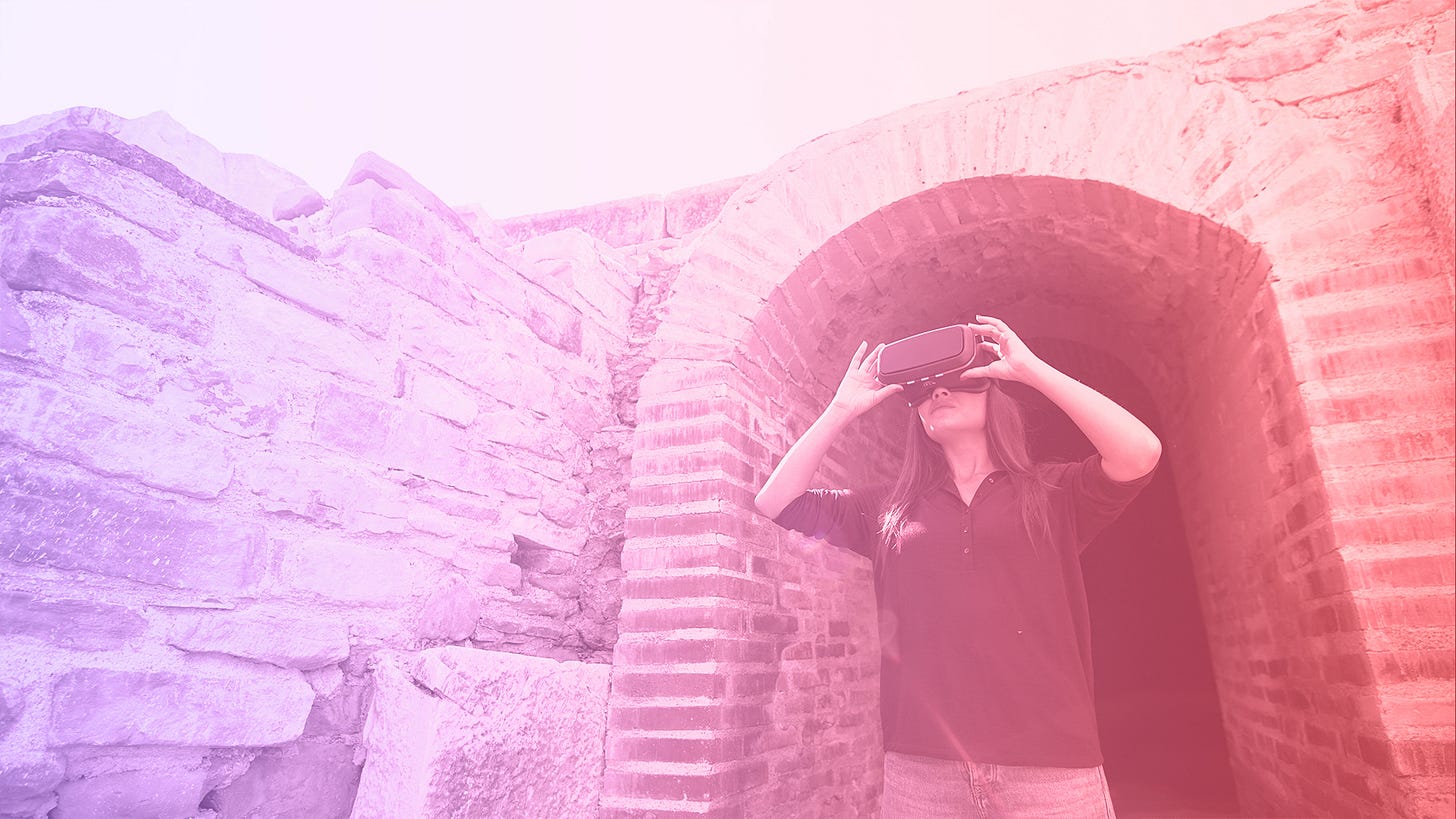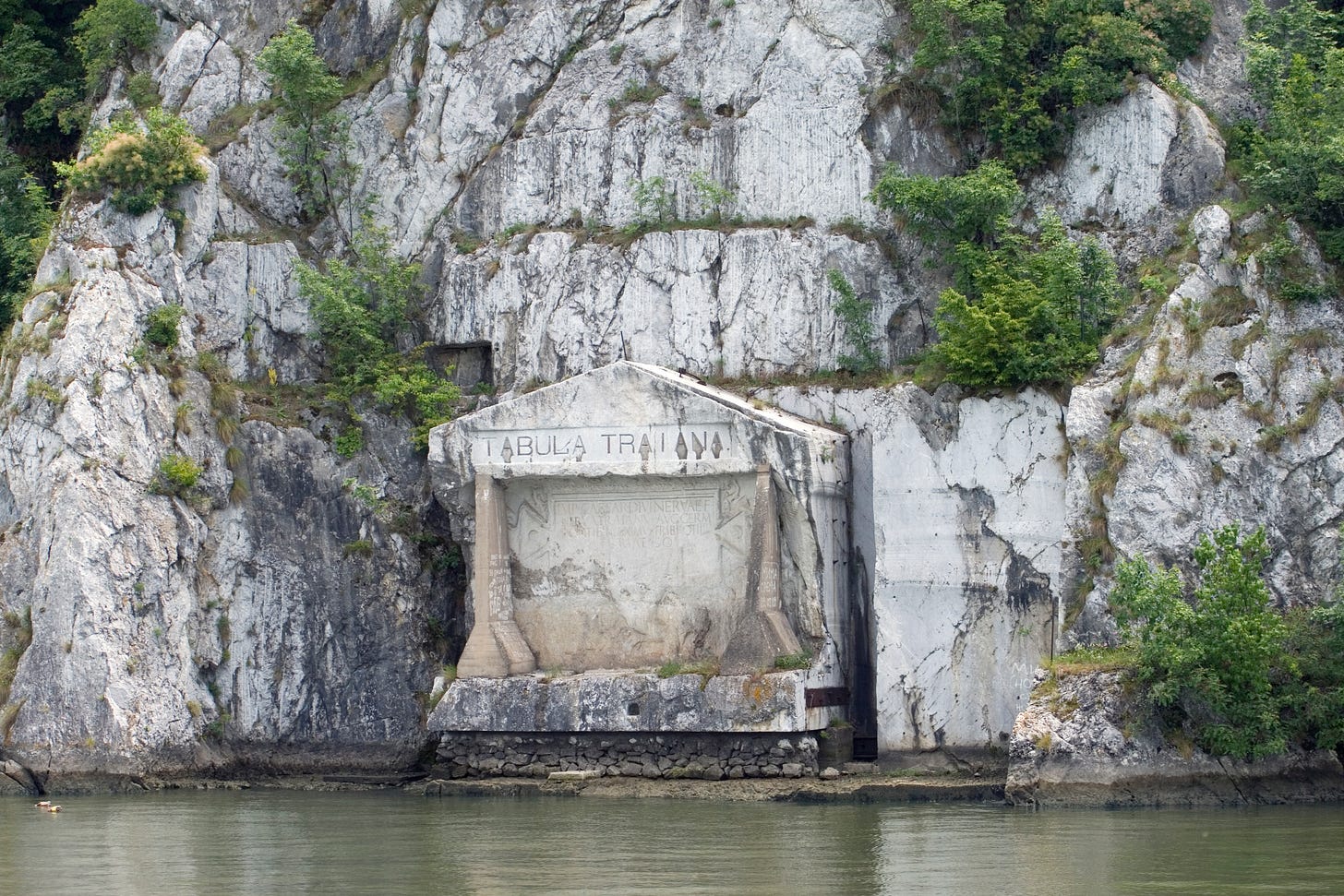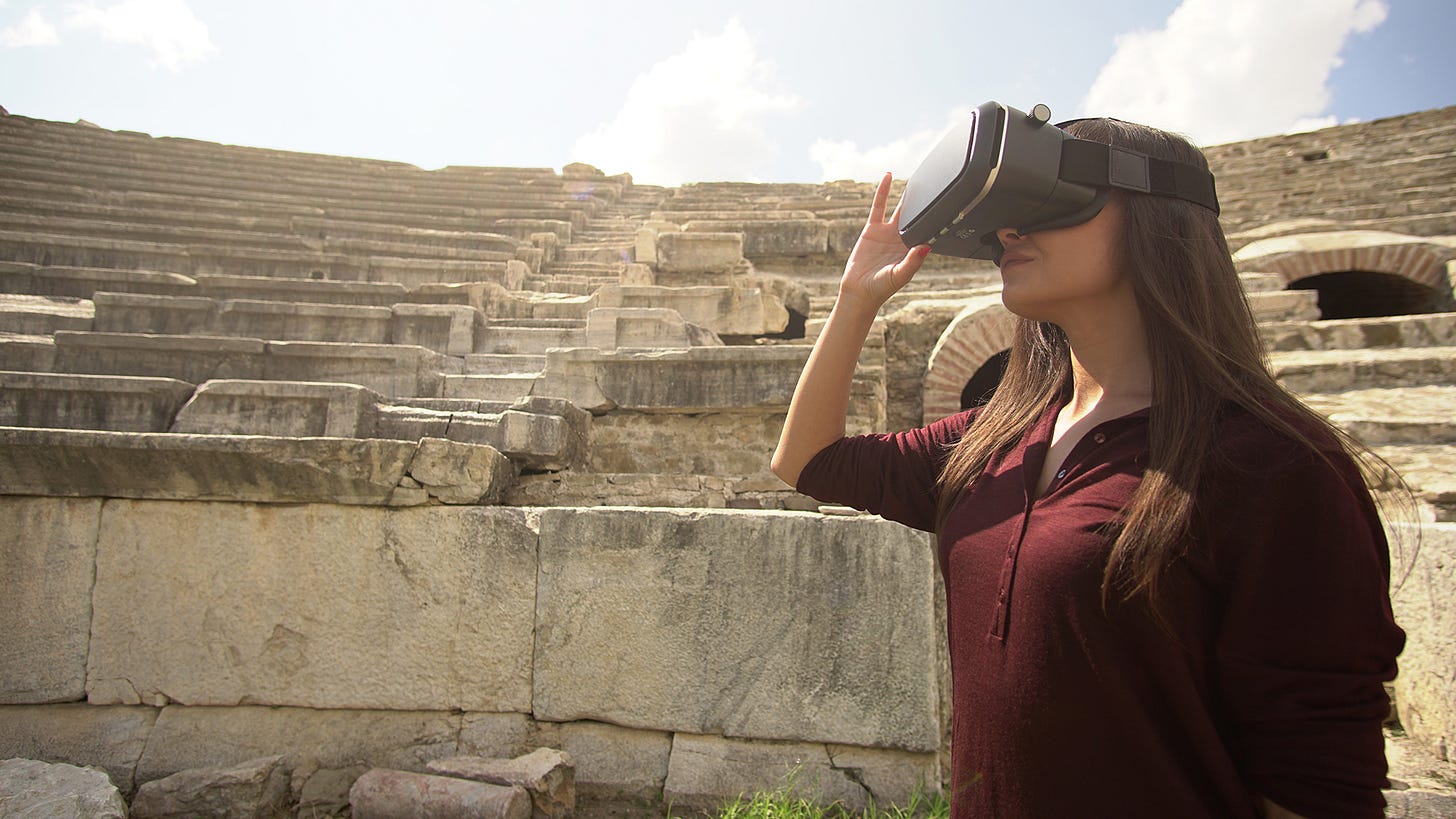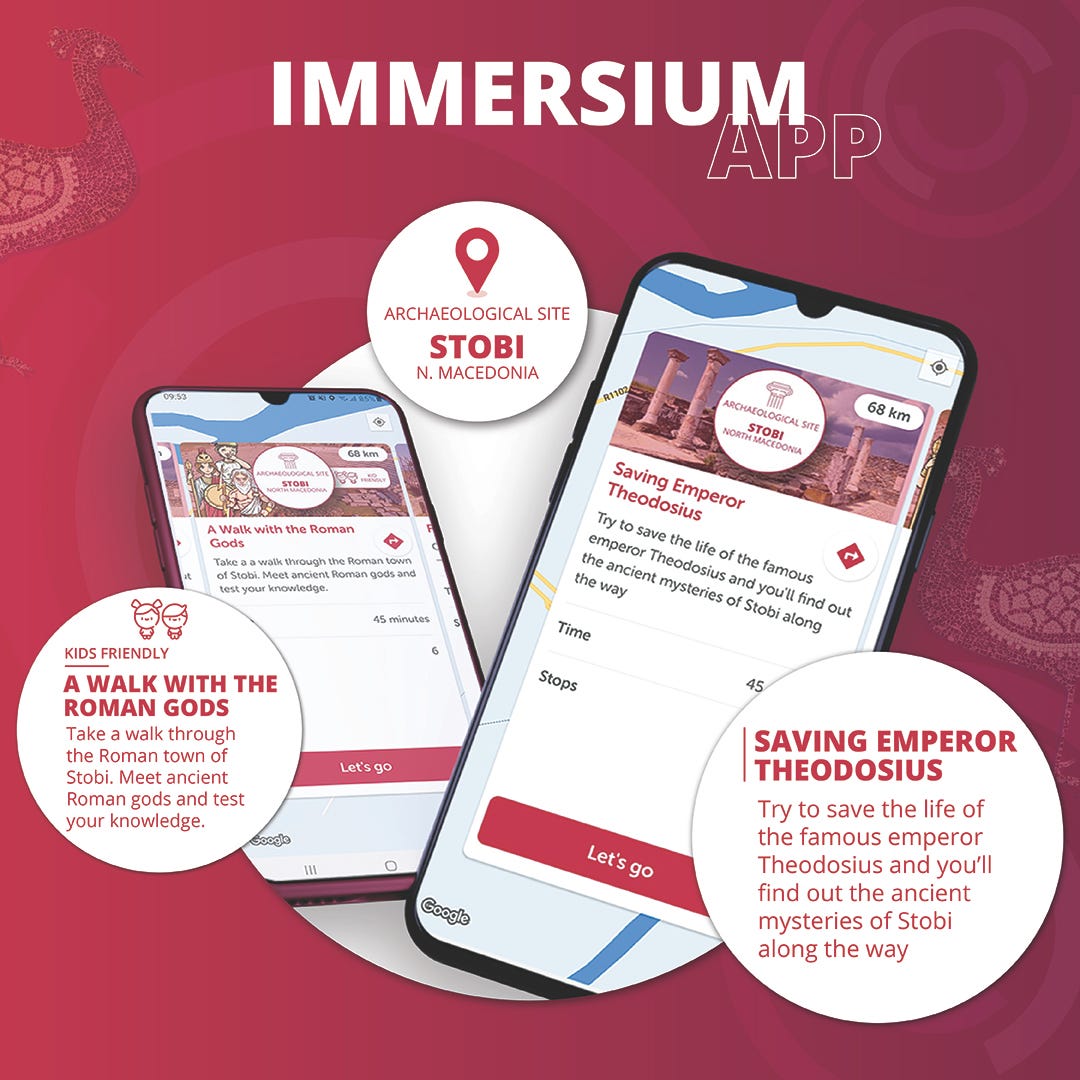S3E16. At the heart of the Empire
The Balkan region was a major political and military center in the Roman Empire since the 1st century. This shared past can be rediscovered through wine and cultural routes and immersive technologies
Hi,
welcome back to BarBalkans, the newsletter (and website) with blurred boundaries.
It is said that all roads lead to Rome. But here at BarBalkans, we have discovered that many, many more lead to the Western Balkans.
If we close our eyes for a moment, we might even find ourselves in the middle of an arena among the gladiators. Or in a late imperial Roman villa. Or in the footsteps of a Roman emperor who brought wine culture to the Danube area.
Because the Balkan region was at the heart of the Roman Empire between the 1st and the 4th centuries. And nearly two thousand years later, this shared heritage is reviving through disruptive cultural and technological initiatives.
Three guests joined BarBalkans to explain how this was made possible. Three guests for two initiatives that best represent the rediscovery of these common roots for the entire peninsula.
All roads - still - lead to the Roman Empire, in the Western Balkans.
All it takes is to open our eyes again.
Millennial paths
«We understood that there was a real potential for the creation of a specific touristic product that merged Roman archaeological sites on one side, and wine production on the other side». This is how Vladan Krečković explains BarBalkans a pioneering project that dates back to 2009.
The Danube Competence Center is an international organization that develops touristic capacities with national, local and private entities. By collaborating with the Serbian Ministry of Tourism, more than 10 years ago it started the Roman Emperors and Danube Wine Route, as «we recognized how the Roman heritage connected different Balkan countries».
The Project Coordinator of the Roman Emperors and Danube Wine Route points out that «between the 1st and the 4th centuries the center of power of the Roman Empire was slightly transferred towards East». More and more villas and imperial palaces were built «and up to 17 Roman emperors were born in today’s Serbian territory».
The idea of developing a touristic route linked to Imperial Rome emerged when «we noticed that there is one more thing that also dates back to that period, except for remains of villas, theaters and military camps. That is wine».
At the very beginning of the project, 20 Roman destinations and 12 wine regions were chosen in four countries: Croatia, Serbia, Bulgaria and Romania.
Only six years later, the Route was certified as a European Cultural Route of the Council of Europe: «It was very important, because this the first cultural route that starts from South-Eastern Europe up to different parts of the continent», Krečković confirms.
Starting from that moment, «we dealt with accessibility of the Roman heritage sites, organizing workshops and working on digital technology». The focus is on smaller archaeological areas, «that are very important on a historical point of view but that lack touristic visibility».
Between 2017 and 2018, the Route expanded beyond the four original countries: Bosnia and Herzegovina, Montenegro, Albania, North Macedonia, Hungary and also Slovenia, in 2022. «Now we are present in 10 European countries, with 23 archeological sites and 12 wine regions».
All the new applicants for membership of the Route have to respect some criteria and a narrative defined by Michael Werner, Chairperson of Scientific Committee of the Roman Emperors and Danube Wine Route. He is an archaeologist from the U.S., who studied in Split and «can guarantee the academic relevancy of the archeological sites in the region between the 1st and the 4th centuries».
The greatest novelty of the last three years is related to the YouTube channel. «When the COVID-19 pandemic broke out, a whole new tendency to transfer culture to online platforms began», Krečković recalls the collaboration with «a very good partner for VR technologies production in Belgrade».
The aim is to present the cultural and touristic offer of 15 destinations along the Roman Emperors and Danube Wine Route, with four or five different 360° videos for each city: «The Roman heritage that can be visited, other destination highlights, recommendations of local partners, special trips in the surroundings and Roman Game Festivals, where they exist».
For example, in Ptuj (Slovenia), «Poetovia in the Roman Empire».
Read also: XXXIII. Culture from your couch
But how is the overall state of these Roman archaeological remains? «They are all very well-preserved, especially the UNESCO Heritage Sites», such as Felix Romuliana (Zaječar, Serbia).
Krečković provides a list of the must-see destinations. The architectural remains in Pula (Croatia), the sophisticated sculptures in Narona (Vid, Croatia), the only mosaic representing the antique god of sleep Hypnos in Risinum (Risan, Montenegro), the fascinating site of Buthrotum (Butrint, Albania), the amphitheater in Dürres (Albania), the antique theatre in Ohrid (North Macedonia).
And then Kladovo (Serbia), where Emperor Trajan’s troops built their military camp. Nowadays, there are still the remains of the Trajan’s Bridge, «built in the 2nd century by the Roman Army and for many centuries the longest bridge on the Danube».
Moreover, in the Iron Gate area along the Danube «you can see how Romans used to build a 120-kilometer-long road following the canyon». Halfway, has to be noted the Tabula Traiana, «a big memorial plaque showing how emperors presented themselves to people».
Among the gladiators
It is at one stop of this Route that we can experience the atmosphere of that time, during gladiator games. At the Roman theater of Stobi.
«We asked ourselves how we could create unique and immersive experiences for the visitors in cultural heritage sites and how to convey their storytelling potential through virtual reality application».
Zorica Velkovska and Milan Tanceski, co-founders of the Macedonian softech organization Center for Social Innovation Blink 42-21, explain BarBalkans the birth of the project Gladiators are back in Stobi. Started in November 2019, «the application was launched in late August 2020».
Through the cooperation with the National Institution Stobi, responsible for the management of the largest Roman archeological site in North Macedonia, it has been possible to develop an innovative solution.
«The idea was to utilize the possibilities of virtual reality to put the user at the center of the touristic experience», Tanceski points out. His colleague Velkovska echoes: «The beauty of technology is that it can give you a completely different type of enjoying culture».
A picture is worth a thousand words. «Just imagine 7 thousand people in a 35-meter-high theater, in all its glory, while there are only seven rows left nowadays».
And how is all of this possible?
Thanks to a nine-minute experience with a VR viewer. «This is a journey into the past, in the 3rd century», and even if you are on your own, «in the virtual reality you are part of a group of 7 thousand people, participating in a cultural event that really happened in the theater of Stobi», Velkovska continues.
Even if Stobi was not a military center, gladiators from all over the region went to perform there because a famous and wealthy family paid for people to have fun.
«When the story starts, you are a guest of this family and you participate in a gladiator performance. A narrator guides you through the entrance, finding your seat. And then, when the gladiator games start, you are already part of the public, while a Protocol Master leads the audience through the ceremony».
The co-founders of Blink 42-21 underline that «this is a very educational experience, because you can learn everything about the theater and the gladiator games». For example, «the narrator explains the order of the seats, where the patron and his family stands, what kind of equipment every type of gladiator has». At the end, you vote if the loser will live or die, «as it really happened».
Behind this nine-minute experience there is a lot of hidden work. «We needed a multidisciplinary approach, that brought together all sorts of expertise: directors, screenwriters, animators, VR developers, historians, architects, archeologist», Tanceski reveals.
«Everything began with the historical facts supporting the story» - the organization of gladiator games in Stobi - «through different layers of educational and entertainment aspects in the script».
The results of this first part of the work - the description of the event, the historical time, the types of gladiators and weapons - was «a 40-pages script». Velkovska reveals with a laugh: «We had to put it all together in only two-pages narrative, this is what you hear and experience through the VR viewer!»
Only then, it was possible to realize the 3D reconstruction of the whole theater «in its original shape and size» and the active characters «that you can see clapping their hands or shouting, if you turn your head right and left».
The result is an immersion in the virtual reality that brings you back in Stobi theatre, at the time of Imperial Rome. For an (almost) real experience among the gladiators.
The common heritage
All these experiences have the same origin. «The Roman heritage unites different cultures on the same historical premises», the co-founders Blink 42-21 point out: «In a region that is often very divided on different issues, these remains are something that connect us all».
As Tanceski underlines, «the project in Stobi opened the perspective for a larger impact that the Roman cultural heritage can have on a regional scale, building new narratives for all Europe». In other words, «we need to use culture and history not as a reason for divide, but to cooperate and enjoy storytelling».
The same vision is shared by his colleague: «Usually people in the Western Balkans are not aware of how huge is Roman heritage that they share. No-one can say “this is mine”, not only in Stobi, but everywhere».
This is how «we realized the attractiveness of these stories in the whole region». Because «if you learn something in Slovenia, you may be interested in visiting other sites in Serbia or North Macedonia», Velkovska explains the idea of the new app Immersium, launched in September 2022.
The second project supported by the Creative Europe program, took two years of work. «In just one application, you can learn many stories in different locations and countries, connecting the roads of the Roman Empire in the Western Balkans».
Immersium is available in three archaeological sites - Stobi in North Macedonia, Viminatium in Serbia and Emona in Slovenia - with a similar framework of activities, «but the story of each archeological site is told in a different way, emphasizing the characteristics of the specific heritage destination».
This is a new self-guided tool, a mobile app that can be downloaded on your smartphone. And then «you can spend as much time as you want learning historical facts, solving games, using Instagram filters, watching the reconstruction of buildings through the AR».
Velkovska stresses that «this kind of engagement has no geographical limitations and we want to continue working on this model, because we only need to study the archeological materials, decide the story and transfer it in technological solutions».
Her colleague Tanceski concludes with an invite to other archeological sites in the region: «There is a huge opportunity to use the already established platform for telling their stories, too». And connecting them all to the common Roman Empire roots of the Western Balkans.
And there is more.
According to the Project Coordinator of the Roman Emperors and Danube Wine Route Krečković, «one of the most impactful legacy of the Roman Empire in the Western Balkans is Christianity».
Not so surprisingly, considering that the region was a major political and military center in the Roman Empire, when in 313 Emperor Constantine embraced Christianity and made it the dominant religion.
«But there are also other aspects of Roman life that we incorporated in our daily life and that we are not aware of», Krečković adds. For example? «Public administration, architecture solutions… and wine as a gastronomical experience».
Pit stop. Sittin’ at the BarBalkans
We have reached the end of this piece of road.
Wine as a gastronomical experience is what brings us together today. Not only among the Roman archeological sites in the Western Balkans, but also at our bar, the BarBalkans.
As Krečković points out, «the culture of wine production in the Balkan area is related to the Roman Empire». And in particular to one specific emperor: «The first traces of vineyards in the Danube area date back to Emperor Marcus Aurelius Probus».
«What science and history can claim is that in the 3rd century» - specifically, during Emperor Probus’ reign between 232 and 282 - «he created the first vineyards and established a long tradition of wine growing, that is ongoing, especially in Smederevo surroundings».
Let’s continue the BarBalkans journey. We will meet again in two weeks, for the 17th stop.
A big hug and have a good journey!
Your support is essential to realize all that you have read. And even more.
Because a job well done - always aiming to improve - needs many hours and energy, also to keep BarBalkans newsletter free for everyone.
An independent project like this cannot survive without the support of the readers. For this reason I kindly ask you to consider the possibility of donating:
Every second Wednesday of the month you will receive a monthly article-podcast on the Yugoslav Wars, to find out what was happening in the Balkans - right in that month - 30 years ago.
You can listen to the preview of BarBalkans - Podcast on Spreaker and Spotify.
Pay attention! The first time you will receive the newsletter, it may go to spam, or to “Promotions Tab”, if you use Gmail. Just move it to “Inbox” and, on the top of the e-mail, flag the specific option to receive the next ones there.










